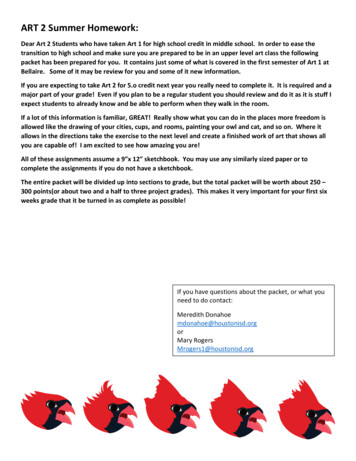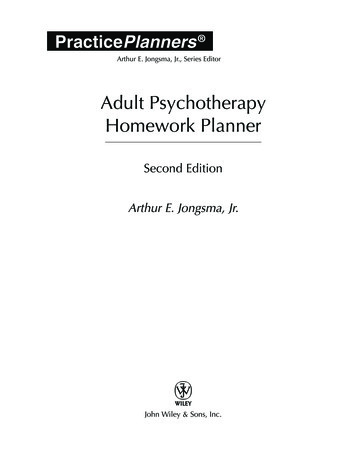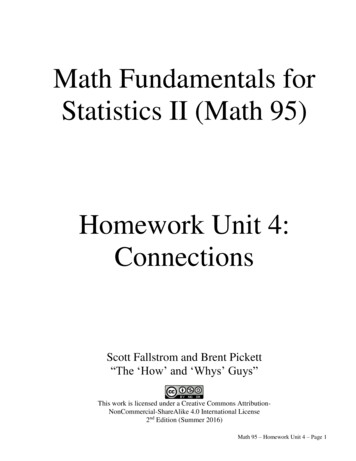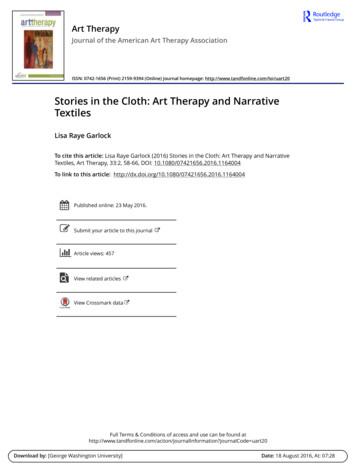
Transcription
ART 2 Summer Homework:Dear Art 2 Students who have taken Art 1 for high school credit in middle school. In order to ease thetransition to high school and make sure you are prepared to be in an upper level art class the followingpacket has been prepared for you. It contains just some of what is covered in the first semester of Art 1 atBellaire. Some of it may be review for you and some of it new information.If you are expecting to take Art 2 for 5.o credit next year you really need to complete it. It is required and amajor part of your grade! Even if you plan to be a regular student you should review and do it as it is stuff Iexpect students to already know and be able to perform when they walk in the room.If a lot of this information is familiar, GREAT! Really show what you can do in the places more freedom isallowed like the drawing of your cities, cups, and rooms, painting your owl and cat, and so on. Where itallows in the directions take the exercise to the next level and create a finished work of art that shows allyou are capable of! I am excited to see how amazing you are!All of these assignments assume a 9”x 12” sketchbook. You may use any similarly sized paper or tocomplete the assignments if you do not have a sketchbook.The entire packet will be divided up into sections to grade, but the total packet will be worth about 250 –300 points(or about two and a half to three project grades). This makes it very important for your first sixweeks grade that it be turned in as complete as possible!1 Point Homework: 60 pointsCubes 7 points (one per cube)Shapes 12 points (4 per shape drawn and shaded)Bird’s Eye City 20 pointsCity Block 20 points2 Point Homework: 30 pointsCubes 7 (1 per cube)If you have questions about the packet, or what youneed to do contact:Table 8 pointsBlocks 15 pointsCups: 20 points each 60 pointsOwl & Cat: 20 points each 40 points1 Point Homework 2 & Room: 50 pointsStairs 7 pointsTable 8 pointsChair 10 points2 point stairs extra credit 10 points extra credit.Room 25 pointsMeredith Donahoemdonahoe@houstonisd.orgorMary RogersMrogers1@houstonisd.org
1 POINT PERSPECTIVE HOMEWORKUse the slideshow at erspective.htm to learn aboutperspective and to help you draw 3 boxes. One at eye level, one below eye level & one above eye level.Then follow the instructions for leaving 2 of the boxes open. Be sure to note vocabulary: vanishing point,horizon line, etc Be aware that the box will change in appearance with its relationship to the vanishing point. Notice how theboxes you draw are different from each other.At least 2 of your boxes will be drawn to appear open. When you draw in the back surface . Draw the entireback of the box in like you see in the box above the horizon. Erase out the part that is covered by the side youwant to close in. You can see that the box on the bottom has no lines remaining in the surface facing front.Draw 4 more boxes for practice to create a design like that below. Put in a background if you desire.ALL LINEAR PERSPECTIVEASSIGNMENTS ARE TOBE COMPLETED WITH ARULER!
Follow the directions on the right for making the 3 shapes 3D using 1 point perspective. Use a Ruler!Draw a horizon line with a single vanishing point in the center.Then, draw these 3 shapes exactlyas you see them. Make sure thesquare edges are true 90 degreeangles.Draw from the corners of yourobjects to the vanishing point. Youneed only do the lines shown.For the curved edge of the centershape you will draw a tangent line.Put one side of your ruler on thevanishing point and line it up withthe outermost part of the curvededge.Draw in the back edges of theobjects. Between each line to thevanishing point you have a linesegment. Your line in back shouldmatch what is drawn in front. Forexample, the top of the first stair ishorizontal so you will draw ahorizontal line between the twolines that go to the vanishing pointfrom the corners of the top of thestair.The form on the right also has ahole cut in the side. Please followthe directions in the picture to dothis.Last, use the vanishing point as a light source and shade the forms with pencil.Shade as neatly and evenly as you can! Flat surfaces have flat value. This means that a flat surface only has one valueacross its entire surface. The value changes only when the direction of the surface changes. Only the curved surface ofthe center object should have any gradual change of value since it changes direction gradually. Also, shading shouldagree across the drawing. All surfaces that are facing the same direction with regards to the light should be the samevalue.
Bird’s Eye View:Use the method yousee on the right tocreate a bird’s eyeview of a city. Thedirections goclockwise. Use aruler to make a neatand refineddrawing.Look at the nextpage to seeexamples of finisheddrawings. I alsohave some links totutorials onYouTube where youcan watch birds’ eyeviews be drawn. Becreative! Makesomething you canbe proud of!https://www.youtube.com/watch?v fnhWl2Z-Gwhttps://www.youtube.com/watch?v tWwMGvDai6Q (Here you may wish to fast-forward to where he beginsthe buildings.)
Examples:
DRAWING A CITY (OR CITY BLOCK) IN 1 POINT PERSPECTIVE:Follow the instructions to learn how to draw a city block inperspective then, draw a block from a city of your own using theinstructions.https://www.youtube.com/watch?v oRYhzrZ8G Yhttps://www.youtube.com/watch?v KeETrcawEIIThe links above are great step-by-step tutorials by “Circle Line ArtSchool”. They are worth studying if you need more step-.by-stepdemonstrations of the assignment.
Examples:
TWO POINT PERSPECTIVE HOMEWORKFollow the directions at http://www.technologystudent.com/designpro twopers1.htm to help you draw acube.ExContinue drawing more boxes or cubes above thehorizon, below the horizon, and at the horizon.Notice how boxes change depending on theirrelationship to the vanishing point and horizon. Ifthey are floating above the horizon you will see thebottom, but at street level or level with thehorizon, you see neither the top nor bottom. Asobjects get closer to the vanishing points on eitherside you see less of the side of the box nearest thevanishing point. Practice drawing at least 7 boxes.Example:
MORE ADVANCED STUDENTS MAY DO AN IMAGINARY STRUCTURE INSTEAD OF THE BOXES.Use your knowledge of how to create more complex forms in perspective to create an abstract environmentor imaginary structure using 2 point perspective. All lines are vertical or drawn to one of the two vanishingpoints. The only horizontal line is the horizon line or those exactly at eye level.https://www.youtube.com/watch?v b3gpvJl-Sas may behelpful to watch before you begin.Examples:
Draw a table in 2 point perspective. USE A RULER!:More complex forms like this table can be created by combining boxes or modifying boxes to make new forms.This tutorial of how to draw a table comes from 2.htmwhere you are welcome to watch the animation. https://www.youtube.com/watch?v 2l8ToJIFQwo nt-perspective-table-legs/ could also be helpful.STAGE ONE: Markboth vanishing pointsand start drawingfaintly - the table top.STAGE TWO: Addthickness to the tabletop remembering toproject all lines to thevanishing pointsSTAGE THREE: Addthe front legs. Noticewhere the further legends in relationship tothe foremost leg and thevanishing point!STAGE FOUR: Addone of the back legs.STAGE FIVE: Add thefinal leg. Notice how itis placed at the crossingpoint of the bottom ofthe outer legs whendrawn to the vanishingpoint
Use the idea of two point perspective construction to correctly sketch the two letter blocks below. Use whatyou have learned about perspective to inform your drawing, but you do not need to have formal vanishingpoints for this exercise. We call this less formal beginning of a drawing a “sketch”, but your final lines shouldbe quite definite. Keep lines light until you are sure they are correct. Use the idea of vanishing points to morecorrectly draw the blocks – sighting approximately to a vanishing point that may be off the page. Draw theboxes in as much detail and as accurately as you can. All the letters should be drawn correctly using the samevanishing point as the side they are on - borders too where this applies. Where you see it the thickness of theborders and letters as they come off the block it should also be drawn. Since the blocks are not parallel theywill not share vanishing points. Only parallel lines/surfaces are drawn to the same vanishing point. Allvanishing points should feel as if they share the same horizon, however, as there is only one eye level in arealistic drawing. You do no need to shade in this exercise, but please draw the cast shadow.
Drawing 3 cups: Drawing and Shading from ObservationYou will draw 3 coffee or tea cup drawings with their saucer: one at eye level, one below eye level, and oneimaginative artwork incorporating a coffee cup. (If you can’t find a cup and saucer you may substitute atakeout cup with its sleeve and top.) One artwork centered on each of 3 sketchbook pages. You may leave asmall border around your centered drawings.You will notice that the circle top of the coffee cup changes in appearance depending on your horizon (eyelevel). Your first 2 drawings will be as realistic drawings of coffee cup and saucer as you can manage. One willbe at eye level like the left-most photo and drawing. One will be below eye level like the photo in the centerand the drawing on the right. The third photo shows a cup above eye level. You will shade it your cups usingpencil. Avoid shading with your finger, but instead build up tone by layering in pencil a little at a time.Examples:
Tips:1. If you are having a problem with wobbly ovalsuse a horizontal or vertical axis (or both) to helpyou make the oval the same on either side or in allquadrants. Also, beware of football shapes.Ovals/circles never have pointy corners!2. Make sure that cups have all the areas ofrendered value present; highlight, mid-tone, coreshadow & reflected light. Rounded objects havethese areas of light and shadow that blend into oneanother gradually. Cast shadows have crisp edges.Flat surfaces do not have large changes in value likerendered value does. Make sure your shadingagrees with your surface!3. Make sure your circles/ovals agree. At thehorizon the circle will appear exactly flat, but ascircles move away from the horizon they appearmore rounded. This means the top of a cup tendsto be flatter in appearance than the base which isfurther down.More Help: Example of how to draw and beginshading the cup. It moves into mixed media, butyou need only use pencil:https://www.youtube.com/watch?v CSBoEHlnvj0Basic shading tips:https://www.youtube.com/watch?v WzszH9BN hI
CRITIQUES of WORK:1.2.1. The shading here is really well done, but there are some problems with ovals and perspective. The top oval is far fromsymmetrical. The bottom of the cup is far too flat! The base of the saucer is also very flat!2. Still mostly and outline drawing. This would not count as a shaded drawing. The drawing is done pretty well, especially thebending of the text around the cup. Some unevenness of oval – the top halves bend more than the bottom halves, but accuratelydrawn aside from that.4.5.6.4. The directions are not followed. No top. No sleeve. The shading is almost entirely done by finger smudging. Circles do not agree.5. Drawing ovals are becoming more flat as they move from the horizon. This is exactly the opposite of what ought to happen, butoverall a convincing rendering.6. More convincing rendering of the lid of the cup than cup 5. White part of cup in drawing 6 has no shading other than a castshadow to show its roundness, but the shading of the sleeve and the top is really well done.7.8.7&8. Shading is good. Circles are all correctly drawn in perspective as are the handles! #8 is a little more confident in the rendering.
The Third Cup:Use your imagination to create an artwork incorporating a coffee cup. This may be done in any mediumincluding collage and/or mixed media. Whatever you choose to do, the artwork should feel like a completedartwork and not an outline sketch.Examples:
PERSPECTIVE HOMEWORK: STAIRS, TABLE & CHAIRSYou have previously the drawn the steps using the steps below with the side of the steps facing you. The backlines of the stairs should be exactly the same as the front lines of the stairs. Lines should go to the vanishingpoint, be horizontal, or be vertical – nothing in between.Now, draw the stairs with the front of the steps facing you. Use the diagram to the above to help. Noticethat the front of each stair is a rectangle with right angles for each corner. You draw from the top corners ofthe rectangle to a vanishing point on the horizon line (point s). The top and bottom edges of the stairs line uplike inclined planes that vanish to a different vanishing point (point v) that is directly above the vanishing pointfor the tops of the stairs (point s). You use these guidelines to help you find how far back the line going to thevanishing point should go before turning up to be the front of the next stair. Then, you also use the topguideline to help you know how tall the next step is.https://www.youtube.com/watch?v VlcSZ53XNkQ can also be helpful if you need more step-by-step.
Then, use the step-by-step below to draw a table in one-point o2/tabper1.htm hosts the tutorial.Last, follow the instructions at http://www.funkypencil.com/easy chair video2.html to draw this chair OR thechair below it by following the instructions at tm.EXTRA CREDIT: Stairs in 2 point perspective https://www.youtube.com/watch?v ddbiqN7QMiM orhttps://www.youtube.com/watch?v ddbiqN7QMiM show two methods for doing this.
Drawing Rooms Homework:When drawing a room in 1 point perspective you will befacing one wall of the room. You should draw it firstfairly small on the page so as to leave room for the wallsand the ceiling & floor coming forward.Next, find your eye level. Where is your eye level inrelationship to the wall? If you are standing it will behigher than if you are sitting. Estimate how high up thewall your eyes are and then draw in the horizon at thatlevel.Your vanishing point will be on the horizon directly whereyou are looking at the wall. If you are sitting or standingto the left the vanishing point will be more left. Do notautomatically center your vanishing point.Once you find your vanishing point use a ruler to drawout from the corners of the back wall using the vanishingpoint. You do not need to keep drawing all the way tothe vanishing pointNotice that the door and windowfacing you are drawn usinghorizontal lines for the top andbottom lines. All horizontal linesthat are facing you will remainhorizontal – like the drawing of therectangle in the front that couldbecome a cabinet or sofa againstthe wall. The rectangle is the sidefacing the viewer. If the door,window or other object is along theside walls you will draw the top andbottom lines to the vanishing point.All edges of surfaces going back inspace will be drawn to thevanishing point. Vertical linesalways remain vertical.If you are drawing an object that will be against the wall and on the floor the corner of the front face needs tointersect with the line going to the vanishing point that divides the wall from floor like the box below the windowthat could become a cabinet or table.
Objects that are drawn against the back wall need to endexactly at the line defining the back wall like the bottom ofthe bookcase here.Other objects may be free standing. Do not be afraid tooverlap. Overlapping will make the picture morebelievable as in the picture of the bedroom below wherethe dresser overlaps the bed.These videos go over how to draw interiors in 1 pointperspective. Watching one or more may be helpful to youwhen starting your own room drawing.https://www.youtube.com/watch?v 2mjSDIBaUlMhttps://www.youtube.com/watch?v 00FPHdLy3Nkhttps://www.youtube.com/watch?v yEymIyLbiAIhttps://www.youtube.com/watch?v QZlLbgAD35sCreate an outline drawing of a room in your home. You need not include every knick-knack and thedirty clothes on the floor, but the room must be in perspective and you must draw the major itemsseen from your viewpoint of the room. Use sight measurement to keep you on track with scale! Youneed not shade in the room, but if you wish to spice up the look of the room add color with watercolor,marker, or colored pencil you may. Only an outline drawing using a ruler to draw to the vanishingpoint is required.
Color Examples:Alternative Room Assignment: For those who would like to design their space rather than draw from lifeyou may design the studio apartment of your dreams and draw it in 1 point perspective as an alternative todrawing a room that already exists in the house.***Remember. Parallel surfaces are drawn to the same vanishing point to couches and beds parallelto or along the wall, counter tops, and so on are all drawn to the same vanishing point, but if you havesomething not parallel to the walls or floor receding back in space it might like have differentvanishing points – like the foreground Barcelona chair in the left corner of the bottom left drawing.
Analogous Owl andComplementary CatUse watercolor, or watercolor and colored pencil ormarkers to complete small color studies. Useanalogous colors to create a painting of an owl, andcomplementary colors to create a painting of a cat.In both cases use the colors to create form andshading – not just to color in. As a general rule thedarker or cooler color from your color palette isusually used as the darker color for shadows and thelighter or warmer of the colors is used in the lightareas of the form. You will want to complete theseon watercolor paper and then paste them into yoursketchbook. The studies can be relatively small soboth studies may fit on your sketchbook page.Other technical notes include: Keeping the white ofthe paper in some of highlight areas is stronglyrecommended. Colors need not be used at fullintensity, but can be more in the semi-neutral range.Backgrounds are often also the cooler of your colorchoices that has been lightened and dulled so to pullback in space. YOU ARE TO USE NO BLACK!!!!! Mixdarker colors by mixing in the complementary color(i.e. a dark forest green is mixed by adding red togreen.)Analagous colors next to each other on the color wheel & sharinga common hue.Complimentary colors opposite each other on the color wheel.These colors dull and darken each other when mixed.Please do not copy these examples, but createyour own original work.*Note that no other colors are used in the complementary cat painting here. Only yellow and purple.
level). Your first 2 drawings will be as realistic drawings of coffee cup and saucer as you can manage. One will be at eye level like the left-most photo and drawing. One will be below eye level like the photo in the center and the drawing on the right. The third photo shows a cup a











